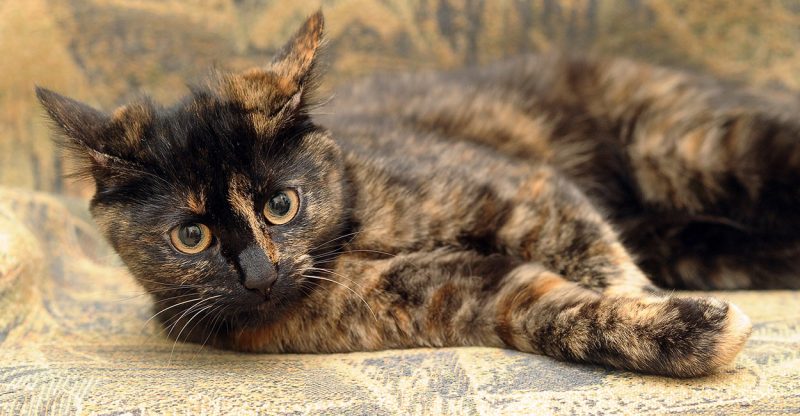If you’re a certified feline lover, you probably already know a lot about them. There are a plethora of cat breeds out there.
While the World Cat Federation recognizes 40 cat breeds, some organizations list more than that.
Aside from breeds, our lovable fur-babies can also be classified by their coat. One of the most known types is the Tortoiseshell Cat or also called Torties.
The markings on its body are similar to that of a tortoiseshell; hence, the name.
If you ever plan on having these exquisitely-colored felines or if you already have one (or more), then you should check out these facts about Tortoiseshell Cats:
1. Torties aren’t an actual feline breed
Some might think that a Tortoiseshell cat is one of the many cat breeds but in reality, it’s just a type of coat color. A true Tortoiseshell cat can be identified through its two prevalent coat colors – red and black.
However, it’s not just exclusively red and black. Shades can still vary from black, brown, red, chocolate, cinnamon, and amber. Its pattern can either be patched or brindled.

Some Tortoiseshell cats appear to have solid colors too, so it can be hard to distinguish them. To be sure, check the hairs on your pet’s back where hair follicles are more abundant.
Tortoiseshell cat coats can be found in some cat breeds such as Cornish Rex, British Shorthair, Persian, Maine Coon, Japanese Bobtail, and Domestic Shorthair.
2. Almost all Torties are female
Have you ever noticed that almost all Torties are female? This is because of genetics. Torties’ distinctive ginger color is because of the “O” gene which is passed on the X chromosome. Female cats have XX chromosome that carries orange and black codes – getting just one “O” gene makes her a Tortoiseshell cat.
As mentioned above, the orange hair gene is passed on the X chromosome. This means that they have a greater chance of getting the “O” gene. Male cats have XY chromosomes; they only need to inherit one O gene to be a ginger cat. Mostly, they end up being entirely orange or completely non-orange.
That’s the reason why Tortoiseshell cats are mostly female. There are cases that males can have XXY chromosomes that can result in the tortoiseshell coloring. However, this can be really rare.
3. All about male Torties
Did you know that approximately, there’s only one male Tortie in every 3000 Tortoiseshell cats born?
Generally, even if they are rare, male Tortoiseshell cats are healthier compared to females. However, most are sterile due to the chromosomal pattern in their DNA that leads to them having abnormal and non-functional tissues in the testes.
Don’t lose hope though. Two fertile Burmese Tortoiseshell Tabby cats were located in the United States, so there still might be a chance for your male Tortie if you ever have one!
4. There are many variations of it
Tortoiseshell cats have different variations depending on their color combination and their names depend on the location too. For instance, in the US and Canada, a Calico exhibits tortoiseshell colors but with patches of white. It is also known as a Tricolour cat.
Meanwhile, a Torbie or Patched Tabby cat is a tortoiseshell cat with tabby cat patterns in their coat. A Bicolor cat has 2 fur colors where one is either solid or patterned color with white patches.
Dilute Tortoiseshell cat – a variation of the Calico Tortoiseshell, has a color pattern of gray, silver, and gold instead of white like a Calico.
There are also cats with blue and cream combination. They are called Blue Tortoiseshell cats. However, these cats are not blue per se, but rather have a blue-gray color.
5. They are connected to a lot of cultural beliefs
Tortoiseshell cats are known in various parts of the world for different cultural reasons. For instance, Ancient Celts believed that male tortoiseshell cats bring luck to their homes.
Some people from Ireland and Scotland believe that aside from bringing luck, these cats have supernatural powers. In the UK, an old English wives tale also says that rubbing a Tortie’s tail on their skin would remove skin warts.
Meanwhile, in the United States, they are coined as “money cats” and that they bring money and good luck.
And finally, in Asia, the Khmers in Cambodia believe that Torties originate from menstrual blood of a young goddess that created the first tortie.
Japanese fishermen thought that bringing a Tortie, especially male ones onto the boat would protect them from storms and ghosts at sea. Some also treat them as a status symbol because of their rare and intricate fur.
6. Famous Torties
When talking about the most notable cats in the world, a Tortie cat named Tama is widely known. She became a Station Master in 2007 at the Kishi Station on the Kishigawa Line in Kinokawa, Japan. She served up and was paid with cat food until her passing in 2015.
Next is Edgar Allan Poe’s tortoiseshell cat named Cattarina. She stays perching on the writer’s shoulder as he wrote his pieces. The bond between the two must be so deep for Cattarina passed away just weeks after his death.
Australia also has its own star named Marzipan – a white tortoiseshell cat living in Melbourne. Marzipan had been a fixture at Astor Theatre since arriving as a stray kitten, interacting with the guest in the cinema. This loved feline died last 2013 at the age of 21 after a long illness.
According to sources, a male Tortie cat named Burrito was born last 2017. A lot of people wanted to adopt him since a male Tortoiseshell cat is rare to come by.
7. What’s with the “tortitude”?
If you own a Tortie, then you may be familiar with what they call as “tortitude” or the attitude of Tortoiseshell cats. Owners usually notice that they are headstrong and have a stronger attitude than other cats.
A study originally published in the Journal of Applied Animal Welfare Science made by veterinarians from the University of California, Davis, shows that cats with Calico and Tortoiseshell coat patterns tend to show this kind of attitude compared to the ones with simpler furs.
However, it is important to note that the variation in aggression between coat colors was fairly low. Also, remember that Tortoiseshell cats are not a breed and their colors alone are not enough of a basis for their temperament.
8. A Tortie’s lifespan and personality
A Tortoiseshell cat’s lifespan may vary depending on its breed. Some may live for just 8-10 years while some can live up to 14 or more. However, it is known that crossbred Torties or simply just mixed-breed cats tend to live longer than purebred cats.
What about their personality? Torties are known as extremely energetic cats. They are perfect if you’re an equally energetic fur parent who likes to stay active. Aside from that, Tortoiseshell cats also have a higher tendency to show a little aggressive behavior.
Although they are quite energetic, these cats also like attention and mostly demand it from their owners. These personality traits shouldn’t deter you from getting one since their breed is the larger factor for the traits that they exhibit.




I had a beautiful tortoise shell cat. For 15 years. She was very affectionate at times, but in a split second she would turn so nasty and bite so hard. I could never figure her out.